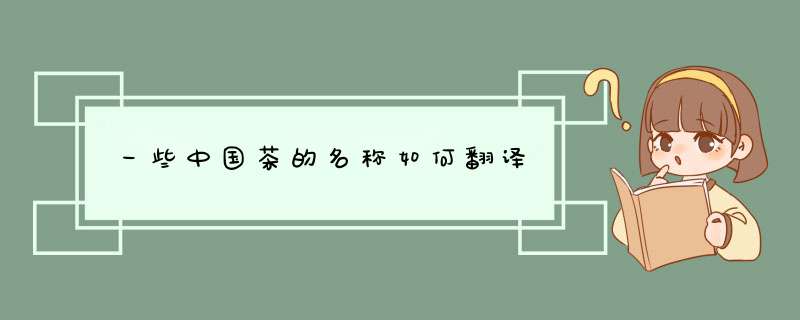
中国产茶历史悠久,茶的品种很多。
根据茶叶的制法和品质可以略分为红茶、绿茶、乌龙茶、花茶和紧压茶(茶砖)五大类。
红茶:经过完全发酵的茶,成品细致,其特点是:红汤红叶;冲泡后汤色红艳鲜亮,清澈见底,香味芬芳浓纯。主要品种有:祁红(安徽祁门)、滇红(云南风庆)、闽红(福建福安)、宜红(湖北 宜昌)、宁红(江西修水)、湖红(湖南安化)、越红(浙江绍兴)等, 以祁红、滇江、宜红质量最佳。
绿茶:是未经发酵的茶,采用高温杀青而保持原有的绿色。主要品种有:龙井(浙江杭州)、大方、碧罗春等。
乌龙茶:也称青茶,属半发酵茶。成品茶外型粗壮松散、成紫褐色,兼有绿茶的鲜浓和红茶的甘醇。主要品种有:武夷岩茶、安溪铁观音、台湾乌龙。
花茶:是将香花放在茶坏中制成。高级花茶香气芬芳、滋味浓厚、汤色清澈。主要品种有:茉莉花茶、桂花茶、玫瑰花茶、柚花茶等。花茶主要产地有:福州、苏州、南昌、杭州等。
紧压茶(茶砖):是用黑茶、晒青和红茶的副茶为原料,经蒸茶、装模压制成形茶叶除上述五类外,还有白茶、黑茶、黄茶、袋泡茶等。
按色泽分
按色泽(或制作工艺)分类可分为:绿茶、黄茶、白茶、青茶、红茶、黑茶。
绿茶为不发酵的茶(发酵度为零),黄茶为微发酵的茶(发酵度为10-20%),白茶为轻度发酵的茶(发酵度为20~30%),青茶为半发酵的茶(发酵度为30~60%),红茶为全发酵的茶(发酵度为80~90%),黑茶为后发酵的茶(发酵度为100%)。
按季节分
按季节分类分为春茶、夏茶、秋茶和冬茶。
春茶是指当年3月下旬到5月中旬之前采制的茶叶。春季温度适中,雨量充沛,再加上茶树经过了半年冬季的休养生息,使得春季茶芽肥硕,色泽翠绿,叶质柔软,且含有丰富的维生素,特别是氨基酸。不但使春茶滋味鲜活且捍气宜人富有保健作用。
夏茶是指5月初至7月初采制的茶叶。夏季天气炎热,茶树新梢芽叶生长迅速,使得能溶解茶汤的水浸出物含量相对养活特别是氨基酸等的养活使得茶汤滋味、香气多不春茶强烈,由于带苦涩味的花青素、咖啡因、茶多酚含量比春茶多,不但使紫色芽叶色泽增加,而且滋味较为苦涩。
秋茶就是8月中旬以后采制的茶叶。秋季气候条件介于春夏之间,茶树经春夏季生长、新梢芽内含物质相对养活叶片大小不一,叶底发脆,叶色发黄,滋味和香气显得比较平和。
冬茶大约在10月下旬开始采制。冬季是在秋茶采完后,气候逐渐转冷后生长的。因冬小麦茶新梢芽生长缓慢,内含物质逐渐增加,所以滋味醇厚,得出气浓烈。
按生长环境分
按其生长环境来分类分为平地茶和高山茶。
平地茶芽叶较小,叶底坚薄,叶面平展,叶色黄绿欠光润。加工后的茶叶条索较细瘦,骨身轻,香气低,滋味淡。
高山茶由于环境适合茶树喜温、喜湿、耐阴的习性,帮有高出好茶的说法。随着海拔高度的不同,造成了高山环境的独特特点,从气温、降雨量、湿度、土壤到山上生长的树木,这些环境对茶树以及茶芽的生长都提供了得天独厚的条件。因此高山茶与平地茶相比,高山茶芽叶肥硕,颜色绿,茸毛多。加工后之欧共体 叶,条索紧结,肥硕,白毫显露,捍气浓郁且耐冲泡。
总的来说,通用的分类方法是将中国茶叶分为基本茶类和再加工茶类。基本茶类分为6类,即绿茶、黄茶、黑茶、白茶、青茶、红茶。以这些基本茶类作原料进行再加工以后的产品统称再加工茶类,主要有花茶、紧压茶、萃取茶、果味茶、药用保健茶和含茶饮料等。
参考资料:
tea culture
Tea culture originated in China
茶文化起源地为中国。
China is the hometown of tea It is said that tea drinking in China began in the Shennong era, at least for more than 4700 years Until now, the Han people still have the custom of using tea instead of ceremony
中国是茶的故乡,中国饮茶,据说始于神农时代,少说也有4700多年了。直到现在,汉族还有民以茶代礼的风俗。
There are many kinds of tea made by the Han people: smoked bean tea from Taihu Lake, scented tea from Suzhou, ginger salt tea from Hunan, Xiajun tea from Shushan, frozen top tea from Taiwan, Longjing tea from Hangzhou, oolong tea from Fujian, Lu'an Guapian from Lu'an, etc
汉族对茶的配制是多种多样的:有太湖的熏豆茶、苏州的香味茶、湖南的姜盐茶、蜀山的侠君茶、台湾的冻顶茶、杭州的龙井茶、福建的乌龙茶六安的六安瓜片等。
中国茶道的发展过程:
1、煎茶:把茶末投入壶中和水一块煎煮。唐代的煎茶,是茶的最早艺术品尝形式。
2、点茶,斗茶:较之于唐代煎茶,宋人更喜爱典雅精致的点茶艺术。由于宋代饮茶之风炽热,所以还风行评比调茶技术和茶质优劣的“斗茶”,亦称“茗战”。中国斗茶始于唐而盛于宋,随着贡茶的兴起应运而生。
3、泡茶:元代人已开始普遍使用茶叶或茶末煎煮饮茶,不加或少加调料。这种简便、纯粹的“清饮”方式被越来越多的人接受,加上后来的沸水冲泡法,到了明代,就形成了“泡茶”这种饮茶方式,一直沿用至今。
茶道是一种以茶为媒的生活礼仪,一种以茶修身的生活方式。下面是我精心为你整理的,一起来看看。
Chinese Tea Culture
China is the home country of tea Before the Tang Dynasty, Chinese tea was exported by land and sea, first to Japan and Korea, then to India and Central Asia and, in the Ming and Qing dynasties, to the Arabian Peninsula In the early period of the 17th century, Chinese tea was exported to Europe, where the upper class adopted the fashion of drinking tea Chinese tea—like Chinese silk and china—has bee synonymous worldwide with refined culture At the heart of the art of tea—the study and practice of tea in all its aspects—is the simple gesture of offering a cup of tea to a guest that for Chinese people today is a fundamental social custom, as it has been for centuries China traces the development of tea as an art form to Lu Yu, known as "the Saint of Tea" in Chinese history, who lived during the Tang Dynasty and who wrote The Book of Tea, the first ever treatise on tea and tea culture The spirit of tea permeates Chinese culture, and throughout the country there are many kinds of teas, teahouses, tea legends, tea artifacts and tea customs Better-known places to enjoy a good cup of tea in China include Beijing noted for its variety of teahouses; Fujian and Guangdong provinces and other places in the southeast of China that serve gongfu tea, a formal serving of tea in tiny cups; the West Lake in Hangzhou, also the home of the Tea Connoisseurs Association, noted for its excellent green tea; and provinces in southwest China like Yunnan where the ethnic groups less affected by foreign cultures retain tea ceremonies and customs in original tea-growing areas
The Chinese people, in their drinking of tea, place much significance on the act of "savoring" "Savoring tea" is not only a way to discern good tea from mediocre tea, but also how people take delight in their reverie and in tea-drinking itself Snatching a bit of leisure from a busy schedule, making a kettle of strong tea, securing a serene space, and serving and drinking tea by yourself can help banish fatigue and frustration, improve your thinking ability and inspire you with enthusia You may also imbibe it slowly in all sips to appreciate the subtle allure of tea-drinking, until your spirits soar up and up into a sublime aesthetic realm Buildings, gardens, ornaments and tea sets are the elements that form the ambience for savoring tea A tranquil, refreshing, fortable and neat locale is certainly desirable for drinking tea Chinese gardens are well known in the world and beautiful Chinese landscapes are too numerous to count Teahouses tucked away in gardens and nestled beside the natural beauty of mountains and rivers are enchanting places of repose for people to rest and recreate themselves
China is a country with a time-honored civilization and a land of ceremony and decorum Whenever guests visit, it is necessary to make and serve tea to them Before serving tea, you may ask them for their preferences as to what kind of tea they fancy and serve them the tea in the most appropriate teacups In the course of serving tea, the host should take careful note of how much water is remaining in the cups and in the kettle Usually, if the tea is made in a teacup, boiling water should be added after half of the cup has been consumed; and thus the cup is kept filled so that the tea retains the same bouquet and remains pleasantly warm throughout the entire course of tea-drinking Snacks, sweets and other dishes may be served at tea time to plement the fragrance of the tea and to allay one's hunger
中国是茶的故乡,早在唐代以前,中国生产的茶叶便通过陆路及海运的方式远销各地。首先到达了日本和韩国,然后传到印度和中亚地区。在明清时期,又传到了 半岛。在17世纪初期,中国茶叶又远销至欧洲各国,很多上层社会的贵族、绅士都养成了喝茶的习惯。中国的共和中国的丝绸及磁器一样,已经成为了中国在全世界的代名词。
中国人饮茶, 注重一个"品"字。"品茶"不但是鉴别茶的优劣,也带有神思遐想和领略饮茶情趣之意。在百忙之中泡上一壶浓茶,择雅静之处,自斟自饮,可以消除疲劳、涤烦益思、振奋精神,也可以细啜慢饮,达到美的享受,使精神世界升华到高尚的艺术境界。品茶的环境一般由建筑物、园林、摆设、茶具等因素组成。饮茶要求安静、清新、舒适、干净。中国园林世界闻名,山水风景更是不可胜数。利用园林或自然山水间,搭设茶室,让人们小憩,意趣盎然。
中国是文明古国,礼仪之邦,很重礼节。凡来了客人,沏茶、敬茶的礼仪是必不可少的。当有客来访,可征求意见,选用最合来客口味的茶叶和最佳茶具待客。主人在陪伴客人饮茶时,要注意客人杯、壶中的茶水残留量,一般用茶杯泡茶,如已喝去一半,就要新增开水,随喝随添,使茶水浓度基本保持前后一致,水温适宜。在饮茶时也可适当佐以茶食、糖果、菜肴等,达到调节口味和点心之功效。
茶道形式
煎茶
把茶末投入壶中和水一块煎煮。最早记述于宋代,有“吃茶”之说。流行于唐代。
法门寺出土的金质茶具,展现了唐代人“吃茶”的情形。茶叶经烘干后碾成粉末,和水一起煮,在煮茶时有时会加入盐等调料,喝茶时与茶叶一起喝下,所以又叫“吃茶”。
唐代的煎茶,是茶的最早艺术品尝形式。
斗茶
古代文人雅士各携带茶与水,通过比茶面汤花和品尝鉴赏茶汤以定优劣的一种品茶艺术。斗茶又称为茗战,兴于唐代末,盛于宋代。最先流行于福建建州一带。斗茶是古代品茶艺术的最高表现形式。其最终目的是品尝,特别是要吸掉茶面上的汤花,最后斗茶者还要品茶汤,做到色、香、味三者俱佳,才算斗茶的最后胜利。
工夫茶
清代 至今某些地区流行的工夫茶是唐、宋以来品茶艺术的流风余韵。清代工夫茶流行于福建的汀州、漳州、泉州和广东的潮州。后来在安徽祁门地区也有盛行。工夫茶讲究品饮工夫。饮工夫茶,有自煎自品和待客两种,特别是待客,更为讲究。
欢迎分享,转载请注明来源:浪漫分享网

 微信扫一扫
微信扫一扫
 支付宝扫一扫
支付宝扫一扫
评论列表(0条)